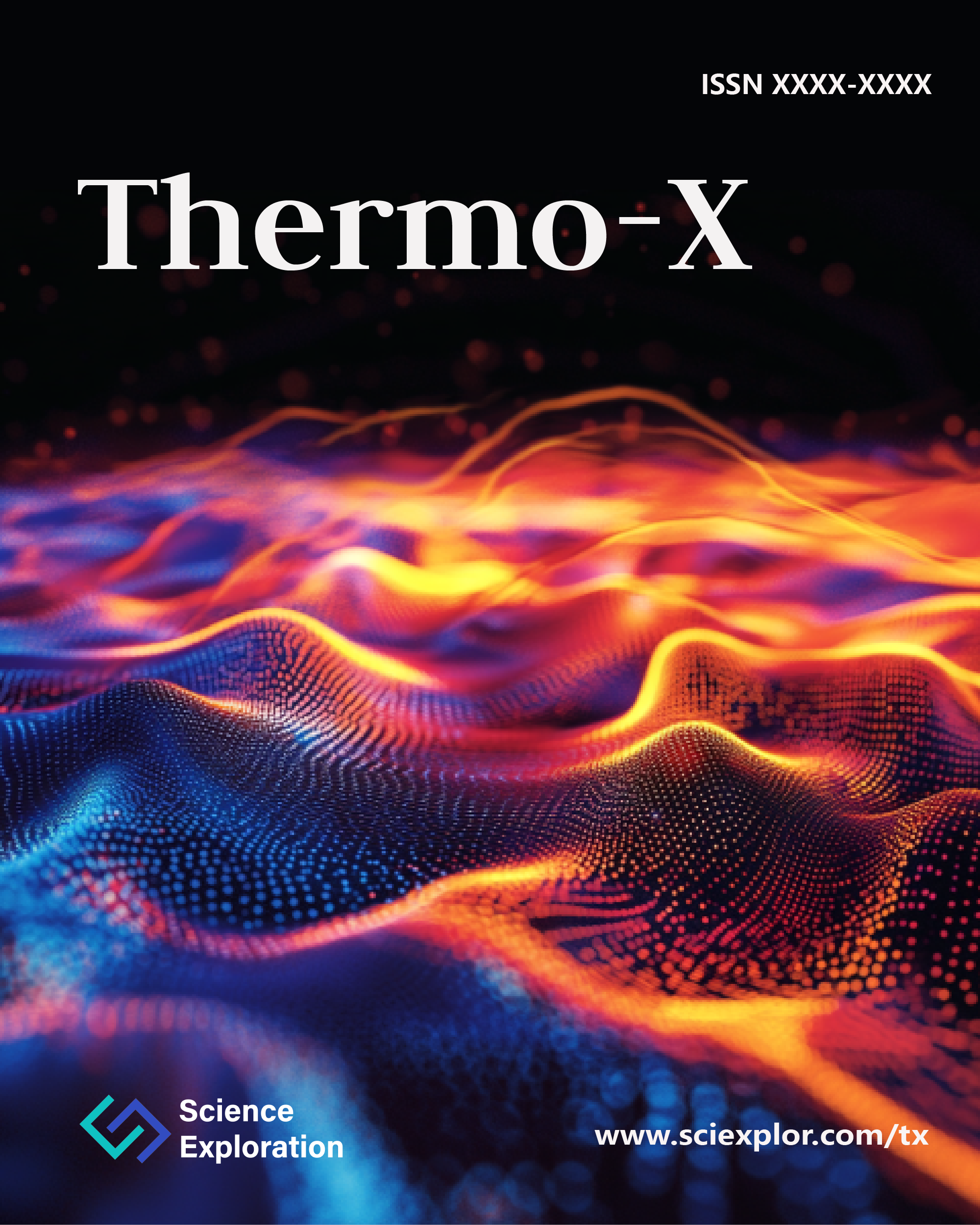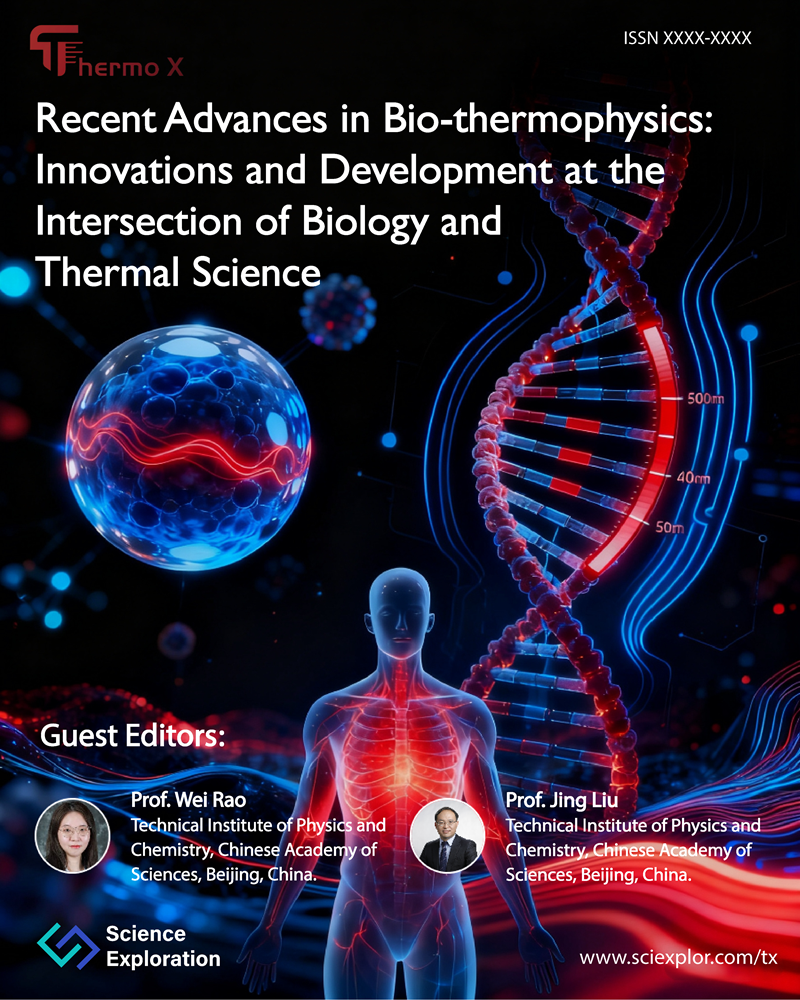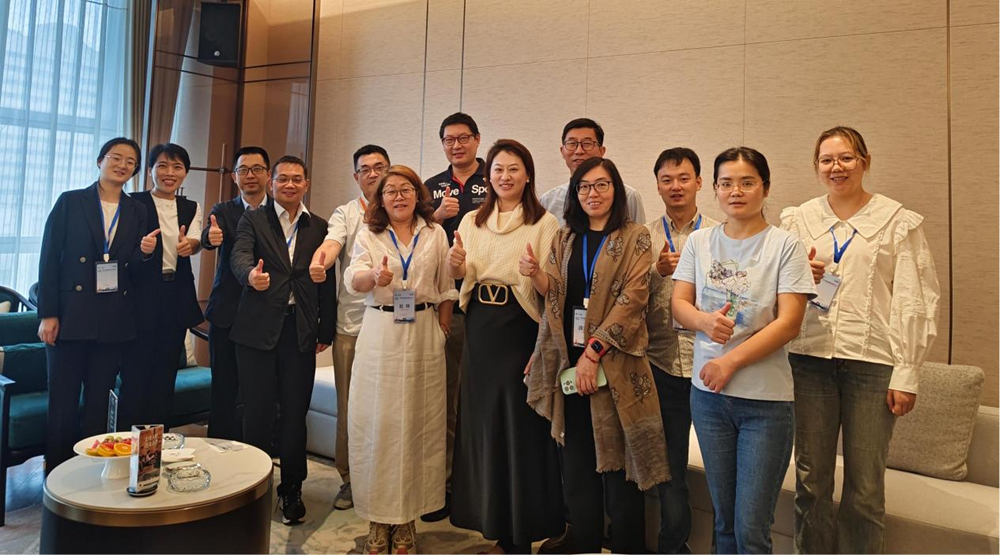
-
Thermo-X is a peer-reviewed, open access journal published quarterly and owned by Science Exploration Press. The journal a comprehensive scope, ranging from theoretical insights into the physics of heat, heat conduction, and quantum heat engines, to applied research on thermal energy storage, heat exchangers, thermal management, and sustainable heat-driven processes. Our mission is to provide a platform for scientists and researchers to share their experimental and theoretical advancements in a detailed, open-access format, fostering innovation and collaboration in the thermal sciences. more >
Articles
Inaugural Editorial of Thermo-X
-
Baowen Li
-
DOI: https://doi.org/10.70401/tx.2025.0006 - November 13, 2025
Anisotropic conductive phase change composites enabled by parallel expanded graphite sheets for solar-thermal energy storage
-
Phase change materials possess significant potential for solar-thermal energy storage yet face critical limitations, including structural instability, inherently poor heat conductivity, and inadequate solar absorption, thereby constraining their ...
MorePhase change materials possess significant potential for solar-thermal energy storage yet face critical limitations, including structural instability, inherently poor heat conductivity, and inadequate solar absorption, thereby constraining their practical applications. To address these challenges, we developed a laminated phase change composite (PCC) via pressure-assisted lamination of paraffin wax-olefin block copolymer (PW-OBC) with expanded graphite (EG) sheets. Experiments indicate that the OBC in the well-mixed PW-OBC sheet forms a three-dimensional network that encases the PW, enabling excellent leakage resistance, thermal/cyclic durability, and shape stability. The parallel EG sheets establish directional and continuous heat transport channels, resulting in 4.54 W·m-1·K-1 lengthwise heat conductivity versus a transverse value of 0.49 W·m-1·K-1, with an excellent thermal conductive anisotropy of 9.27. Coating the PCC surface with carbon black enhances its solar irradiation absorption, yielding a solar absorptivity of 0.98. Benefiting from the synergy of anisotropic heat conduction and enhanced solar absorption, the PCC can attain 79.2%-96.5% solar-thermal efficiency within 1-3 suns irradiance, enabling effective solar energy capture and storage. These results provide a viable approach for producing high-performance, anisotropically conductive PCCs for efficient low- to medium-temperature solar-thermal applications.
Less -
Heqi Huang, ... Hongjie Yan
-
DOI: https://doi.org/10.70401/tx.2025.0005 - October 29, 2025
High-performance electrocaloric cooling devices for efficient and compact solid-state refrigeration
-
The electrocaloric (EC) effect represents the changes of polarization entropy and/or temperature of dielectrics when an external electric field is applied and removed. An efficient EC effect relies on a highly reversible conversion between electrical energy ...
MoreThe electrocaloric (EC) effect represents the changes of polarization entropy and/or temperature of dielectrics when an external electric field is applied and removed. An efficient EC effect relies on a highly reversible conversion between electrical energy and thermal energy. Based on this effect, EC refrigeration has demonstrated advantages in terms of high energy efficiency, zero direct carbon emissions, and high specific volumetric cooling power densities. Consequently, EC refrigeration is recognized as one of the promising alternative technologies for next-generation refrigeration and heat pump. Over the past two decades, EC cooling devices have been extensively developed, driven by advances in EC materials and working bodies. In this review, we summarize recent progress in EC cooling devices, focusing on the mechanisms of solid-state refrigerants and thermodynamic cycles within these systems, and highlighting the characteristics of devices operating on different working principles.
Less -
Donglin Han, ... Xiaoshi Qian
-
DOI: https://doi.org/10.70401/tx.2025.0004 - September 26, 2025
An ITO thermochromic hydrogel-based smart window for balancing indoor daylight comfort and energy regulation
-
Enhancing indoor visual comfort is crucial for the practical deployment of thermochromic smart windows. However, their application is often hindered by the low visible light transmittance (Tlum) in the activated state. In this study, we propose ...
MoreEnhancing indoor visual comfort is crucial for the practical deployment of thermochromic smart windows. However, their application is often hindered by the low visible light transmittance (Tlum) in the activated state. In this study, we propose a thermally and optically dual-responsive smart window that improves both building energy efficiency and Tlum in the activated state. The design is based on a polyacrylamide (PAm)/poly(N-isopropylacrylamide) (PNIPAm)/indium tin oxide (ITO) composite film (PPI). Within this structure, PAm provides a hydrophilic matrix, PNIPAm microgels enable thermoresponsive optical modulation through reversible transmittance changes across the response temperature, and ITO particles act as light-to-heat transducers due to their photothermal and infrared reflective properties. Compared with the PNIPAm hydrogel film, the PPI composite film increases Tlum in the activated state from 9.7% to 50.0% and enhances infrared modulation capability from 39.2% to 50.4%. Under an illumination intensity of 95 mW·cm-2, the PPI composite film lowers the indoor temperature of simulated buildings by up to 7 °C. This dual-responsive thermochromic window provides improved indoor visual comfort along with effective temperature regulation, offering a promising strategy for advancing the practical use of smart windows.
Less -
Zhucheng Jiang, ... Wei Feng
-
DOI: https://doi.org/10.70401/tx.2025.0003 - September 22, 2025
Transient electro-thermal technique for measuring the thermal diffusivity/conductivity of 1D/2D materials: from mm down to atomic scale thickness
-
With the continuous miniaturization of micro-devices and the rapid advancement of novel nanomaterials, thermal characterization techniques tailored for two-dimensional (2D) structures (films and coatings) and one-dimensional (1D) architectures (wires ...
MoreWith the continuous miniaturization of micro-devices and the rapid advancement of novel nanomaterials, thermal characterization techniques tailored for two-dimensional (2D) structures (films and coatings) and one-dimensional (1D) architectures (wires and fibers) have become essential for elucidating structure-property relationships and optimizing material performance. This review provides an in-depth analysis of the Transient Electro-Thermal (TET) technique, a recently developed method for measuring the thermal diffusivity and conductivity of 1D and 2D materials, including dielectric, metallic, and semiconductive films, coatings, and wires/fibers. We discuss the fundamental principles of TET operation, the associated physical and mathematical models for data reduction, and critical methodologies for data fitting, uncertainty analysis, and stray heat transfer mitigation to ensure high repeatability and accuracy. In addition, the latest developments and applications of TET are highlighted, including its extension to atomic-scale thickness, in-situ dynamic thermal property measurements during structural evolution, and the zero-temperature-rise limit method. The outstanding agreement (within ~0.6%) between the measured and reference thermal diffusivity of a Pt wire, validated through extensive experiments and zero-temperature-rise extrapolation, demonstrates the robustness and reliability of the TET technique. Owing to its simplicity in principles, experimental implementation, and data analysis, TET offers significant advantages in uncertainty control, measurement accuracy, and throughput.
Less -
Yangsu Xie, ... Xinwei Wang
-
DOI: https://doi.org/10.70401/tx.2025.0002 - July 31, 2025
High-performance electrocaloric cooling devices for efficient and compact solid-state refrigeration
-
The electrocaloric (EC) effect represents the changes of polarization entropy and/or temperature of dielectrics when an external electric field is applied and removed. An efficient EC effect relies on a highly reversible conversion between electrical energy ...
MoreThe electrocaloric (EC) effect represents the changes of polarization entropy and/or temperature of dielectrics when an external electric field is applied and removed. An efficient EC effect relies on a highly reversible conversion between electrical energy and thermal energy. Based on this effect, EC refrigeration has demonstrated advantages in terms of high energy efficiency, zero direct carbon emissions, and high specific volumetric cooling power densities. Consequently, EC refrigeration is recognized as one of the promising alternative technologies for next-generation refrigeration and heat pump. Over the past two decades, EC cooling devices have been extensively developed, driven by advances in EC materials and working bodies. In this review, we summarize recent progress in EC cooling devices, focusing on the mechanisms of solid-state refrigerants and thermodynamic cycles within these systems, and highlighting the characteristics of devices operating on different working principles.
Less -
Donglin Han, ... Xiaoshi Qian
-
DOI: https://doi.org/10.70401/tx.2025.0004 - September 26, 2025
Transient electro-thermal technique for measuring the thermal diffusivity/conductivity of 1D/2D materials: from mm down to atomic scale thickness
-
With the continuous miniaturization of micro-devices and the rapid advancement of novel nanomaterials, thermal characterization techniques tailored for two-dimensional (2D) structures (films and coatings) and one-dimensional (1D) architectures (wires ...
MoreWith the continuous miniaturization of micro-devices and the rapid advancement of novel nanomaterials, thermal characterization techniques tailored for two-dimensional (2D) structures (films and coatings) and one-dimensional (1D) architectures (wires and fibers) have become essential for elucidating structure-property relationships and optimizing material performance. This review provides an in-depth analysis of the Transient Electro-Thermal (TET) technique, a recently developed method for measuring the thermal diffusivity and conductivity of 1D and 2D materials, including dielectric, metallic, and semiconductive films, coatings, and wires/fibers. We discuss the fundamental principles of TET operation, the associated physical and mathematical models for data reduction, and critical methodologies for data fitting, uncertainty analysis, and stray heat transfer mitigation to ensure high repeatability and accuracy. In addition, the latest developments and applications of TET are highlighted, including its extension to atomic-scale thickness, in-situ dynamic thermal property measurements during structural evolution, and the zero-temperature-rise limit method. The outstanding agreement (within ~0.6%) between the measured and reference thermal diffusivity of a Pt wire, validated through extensive experiments and zero-temperature-rise extrapolation, demonstrates the robustness and reliability of the TET technique. Owing to its simplicity in principles, experimental implementation, and data analysis, TET offers significant advantages in uncertainty control, measurement accuracy, and throughput.
Less -
Yangsu Xie, ... Xinwei Wang
-
DOI: https://doi.org/10.70401/tx.2025.0002 - July 31, 2025
Strong lattice anharmonicity and glass-like lattice thermal conductivity in nitrohalide double antiperovskites: A case study based on machine-learning potentials
-
Antiperovskites have attracted significant interest in the field of energy conversion in recent years. While extensive research has focused on the magnetism, ionic conductivity and superconductivity of antiperovskites, their thermal properties including ...
MoreAntiperovskites have attracted significant interest in the field of energy conversion in recent years. While extensive research has focused on the magnetism, ionic conductivity and superconductivity of antiperovskites, their thermal properties including lattice anharmonicity and thermal transport remain less explored compared to their well-studied perovskite counterparts. Recently, nitrohalide double antiperovskites have been successfully synthesized. In this work, we investigate the thermal transport properties of nitrohalide double antiperovskites
LessLi6NII2 and Li6NBrBr2 using first-principles machine-learning potentials. Our results reveal that within the perturbation theory framework, imaginary phonons appear throughout the entire Brillouin zone in both the harmonic regime and at elevated temperatures. Atomic vibrational analysis indicates that stochastic Li-ion movements confined within a single conventional unit cell are responsible for the presence of these imaginary phonons. Furthermore, homogeneous nonequilibrium molecular dynamics and equilibrium molecular dynamics simulations demonstrate that Li6NII2 and Li6NBrBr2 exhibit ultralow glass-like lattice thermal conductivities. Spectral thermal conductivity analysis shows that the dominant contributions arise from phonons with frequencies below 5 THz and around 11 THz. The substantial phonon contribution near 11 THz is attributed to the confined stochastic motions of Li ions. This work uncovers the unconventional microscopic cation dynamics and strong lattice anharmonicity in double antiperovskites Li6NII2 and Li6NBrBr2, thereby advancing the understanding of phonon transport in these materials. -
Yuan Li, ... Jian-Hua Jiang
-
DOI: https://doi.org/10.70401/tx.2025.0001 - July 10, 2025
An ITO thermochromic hydrogel-based smart window for balancing indoor daylight comfort and energy regulation
-
Enhancing indoor visual comfort is crucial for the practical deployment of thermochromic smart windows. However, their application is often hindered by the low visible light transmittance (Tlum) in the activated state. In this study, we propose ...
MoreEnhancing indoor visual comfort is crucial for the practical deployment of thermochromic smart windows. However, their application is often hindered by the low visible light transmittance (Tlum) in the activated state. In this study, we propose a thermally and optically dual-responsive smart window that improves both building energy efficiency and Tlum in the activated state. The design is based on a polyacrylamide (PAm)/poly(N-isopropylacrylamide) (PNIPAm)/indium tin oxide (ITO) composite film (PPI). Within this structure, PAm provides a hydrophilic matrix, PNIPAm microgels enable thermoresponsive optical modulation through reversible transmittance changes across the response temperature, and ITO particles act as light-to-heat transducers due to their photothermal and infrared reflective properties. Compared with the PNIPAm hydrogel film, the PPI composite film increases Tlum in the activated state from 9.7% to 50.0% and enhances infrared modulation capability from 39.2% to 50.4%. Under an illumination intensity of 95 mW·cm-2, the PPI composite film lowers the indoor temperature of simulated buildings by up to 7 °C. This dual-responsive thermochromic window provides improved indoor visual comfort along with effective temperature regulation, offering a promising strategy for advancing the practical use of smart windows.
Less -
Zhucheng Jiang, ... Wei Feng
-
DOI: https://doi.org/10.70401/tx.2025.0003 - September 22, 2025
Anisotropic conductive phase change composites enabled by parallel expanded graphite sheets for solar-thermal energy storage
-
Phase change materials possess significant potential for solar-thermal energy storage yet face critical limitations, including structural instability, inherently poor heat conductivity, and inadequate solar absorption, thereby constraining their ...
MorePhase change materials possess significant potential for solar-thermal energy storage yet face critical limitations, including structural instability, inherently poor heat conductivity, and inadequate solar absorption, thereby constraining their practical applications. To address these challenges, we developed a laminated phase change composite (PCC) via pressure-assisted lamination of paraffin wax-olefin block copolymer (PW-OBC) with expanded graphite (EG) sheets. Experiments indicate that the OBC in the well-mixed PW-OBC sheet forms a three-dimensional network that encases the PW, enabling excellent leakage resistance, thermal/cyclic durability, and shape stability. The parallel EG sheets establish directional and continuous heat transport channels, resulting in 4.54 W·m-1·K-1 lengthwise heat conductivity versus a transverse value of 0.49 W·m-1·K-1, with an excellent thermal conductive anisotropy of 9.27. Coating the PCC surface with carbon black enhances its solar irradiation absorption, yielding a solar absorptivity of 0.98. Benefiting from the synergy of anisotropic heat conduction and enhanced solar absorption, the PCC can attain 79.2%-96.5% solar-thermal efficiency within 1-3 suns irradiance, enabling effective solar energy capture and storage. These results provide a viable approach for producing high-performance, anisotropically conductive PCCs for efficient low- to medium-temperature solar-thermal applications.
Less -
Heqi Huang, ... Hongjie Yan
-
DOI: https://doi.org/10.70401/tx.2025.0005 - October 29, 2025
Transient electro-thermal technique for measuring the thermal diffusivity/conductivity of 1D/2D materials: from mm down to atomic scale thickness
-
With the continuous miniaturization of micro-devices and the rapid advancement of novel nanomaterials, thermal characterization techniques tailored for two-dimensional (2D) structures (films and coatings) and one-dimensional (1D) architectures (wires ...
MoreWith the continuous miniaturization of micro-devices and the rapid advancement of novel nanomaterials, thermal characterization techniques tailored for two-dimensional (2D) structures (films and coatings) and one-dimensional (1D) architectures (wires and fibers) have become essential for elucidating structure-property relationships and optimizing material performance. This review provides an in-depth analysis of the Transient Electro-Thermal (TET) technique, a recently developed method for measuring the thermal diffusivity and conductivity of 1D and 2D materials, including dielectric, metallic, and semiconductive films, coatings, and wires/fibers. We discuss the fundamental principles of TET operation, the associated physical and mathematical models for data reduction, and critical methodologies for data fitting, uncertainty analysis, and stray heat transfer mitigation to ensure high repeatability and accuracy. In addition, the latest developments and applications of TET are highlighted, including its extension to atomic-scale thickness, in-situ dynamic thermal property measurements during structural evolution, and the zero-temperature-rise limit method. The outstanding agreement (within ~0.6%) between the measured and reference thermal diffusivity of a Pt wire, validated through extensive experiments and zero-temperature-rise extrapolation, demonstrates the robustness and reliability of the TET technique. Owing to its simplicity in principles, experimental implementation, and data analysis, TET offers significant advantages in uncertainty control, measurement accuracy, and throughput.
Less -
Yangsu Xie, ... Xinwei Wang
-
DOI: https://doi.org/10.70401/tx.2025.0002 - July 31, 2025
High-performance electrocaloric cooling devices for efficient and compact solid-state refrigeration
-
The electrocaloric (EC) effect represents the changes of polarization entropy and/or temperature of dielectrics when an external electric field is applied and removed. An efficient EC effect relies on a highly reversible conversion between electrical energy ...
MoreThe electrocaloric (EC) effect represents the changes of polarization entropy and/or temperature of dielectrics when an external electric field is applied and removed. An efficient EC effect relies on a highly reversible conversion between electrical energy and thermal energy. Based on this effect, EC refrigeration has demonstrated advantages in terms of high energy efficiency, zero direct carbon emissions, and high specific volumetric cooling power densities. Consequently, EC refrigeration is recognized as one of the promising alternative technologies for next-generation refrigeration and heat pump. Over the past two decades, EC cooling devices have been extensively developed, driven by advances in EC materials and working bodies. In this review, we summarize recent progress in EC cooling devices, focusing on the mechanisms of solid-state refrigerants and thermodynamic cycles within these systems, and highlighting the characteristics of devices operating on different working principles.
Less -
Donglin Han, ... Xiaoshi Qian
-
DOI: https://doi.org/10.70401/tx.2025.0004 - September 26, 2025
Strong lattice anharmonicity and glass-like lattice thermal conductivity in nitrohalide double antiperovskites: A case study based on machine-learning potentials
-
Antiperovskites have attracted significant interest in the field of energy conversion in recent years. While extensive research has focused on the magnetism, ionic conductivity and superconductivity of antiperovskites, their thermal properties including ...
MoreAntiperovskites have attracted significant interest in the field of energy conversion in recent years. While extensive research has focused on the magnetism, ionic conductivity and superconductivity of antiperovskites, their thermal properties including lattice anharmonicity and thermal transport remain less explored compared to their well-studied perovskite counterparts. Recently, nitrohalide double antiperovskites have been successfully synthesized. In this work, we investigate the thermal transport properties of nitrohalide double antiperovskites
LessLi6NII2 and Li6NBrBr2 using first-principles machine-learning potentials. Our results reveal that within the perturbation theory framework, imaginary phonons appear throughout the entire Brillouin zone in both the harmonic regime and at elevated temperatures. Atomic vibrational analysis indicates that stochastic Li-ion movements confined within a single conventional unit cell are responsible for the presence of these imaginary phonons. Furthermore, homogeneous nonequilibrium molecular dynamics and equilibrium molecular dynamics simulations demonstrate that Li6NII2 and Li6NBrBr2 exhibit ultralow glass-like lattice thermal conductivities. Spectral thermal conductivity analysis shows that the dominant contributions arise from phonons with frequencies below 5 THz and around 11 THz. The substantial phonon contribution near 11 THz is attributed to the confined stochastic motions of Li ions. This work uncovers the unconventional microscopic cation dynamics and strong lattice anharmonicity in double antiperovskites Li6NII2 and Li6NBrBr2, thereby advancing the understanding of phonon transport in these materials. -
Yuan Li, ... Jian-Hua Jiang
-
DOI: https://doi.org/10.70401/tx.2025.0001 - July 10, 2025
An ITO thermochromic hydrogel-based smart window for balancing indoor daylight comfort and energy regulation
-
Enhancing indoor visual comfort is crucial for the practical deployment of thermochromic smart windows. However, their application is often hindered by the low visible light transmittance (Tlum) in the activated state. In this study, we propose ...
MoreEnhancing indoor visual comfort is crucial for the practical deployment of thermochromic smart windows. However, their application is often hindered by the low visible light transmittance (Tlum) in the activated state. In this study, we propose a thermally and optically dual-responsive smart window that improves both building energy efficiency and Tlum in the activated state. The design is based on a polyacrylamide (PAm)/poly(N-isopropylacrylamide) (PNIPAm)/indium tin oxide (ITO) composite film (PPI). Within this structure, PAm provides a hydrophilic matrix, PNIPAm microgels enable thermoresponsive optical modulation through reversible transmittance changes across the response temperature, and ITO particles act as light-to-heat transducers due to their photothermal and infrared reflective properties. Compared with the PNIPAm hydrogel film, the PPI composite film increases Tlum in the activated state from 9.7% to 50.0% and enhances infrared modulation capability from 39.2% to 50.4%. Under an illumination intensity of 95 mW·cm-2, the PPI composite film lowers the indoor temperature of simulated buildings by up to 7 °C. This dual-responsive thermochromic window provides improved indoor visual comfort along with effective temperature regulation, offering a promising strategy for advancing the practical use of smart windows.
Less -
Zhucheng Jiang, ... Wei Feng
-
DOI: https://doi.org/10.70401/tx.2025.0003 - September 22, 2025
Anisotropic conductive phase change composites enabled by parallel expanded graphite sheets for solar-thermal energy storage
-
Phase change materials possess significant potential for solar-thermal energy storage yet face critical limitations, including structural instability, inherently poor heat conductivity, and inadequate solar absorption, thereby constraining their ...
MorePhase change materials possess significant potential for solar-thermal energy storage yet face critical limitations, including structural instability, inherently poor heat conductivity, and inadequate solar absorption, thereby constraining their practical applications. To address these challenges, we developed a laminated phase change composite (PCC) via pressure-assisted lamination of paraffin wax-olefin block copolymer (PW-OBC) with expanded graphite (EG) sheets. Experiments indicate that the OBC in the well-mixed PW-OBC sheet forms a three-dimensional network that encases the PW, enabling excellent leakage resistance, thermal/cyclic durability, and shape stability. The parallel EG sheets establish directional and continuous heat transport channels, resulting in 4.54 W·m-1·K-1 lengthwise heat conductivity versus a transverse value of 0.49 W·m-1·K-1, with an excellent thermal conductive anisotropy of 9.27. Coating the PCC surface with carbon black enhances its solar irradiation absorption, yielding a solar absorptivity of 0.98. Benefiting from the synergy of anisotropic heat conduction and enhanced solar absorption, the PCC can attain 79.2%-96.5% solar-thermal efficiency within 1-3 suns irradiance, enabling effective solar energy capture and storage. These results provide a viable approach for producing high-performance, anisotropically conductive PCCs for efficient low- to medium-temperature solar-thermal applications.
Less -
Heqi Huang, ... Hongjie Yan
-
DOI: https://doi.org/10.70401/tx.2025.0005 - October 29, 2025
Special Issues
Recent Advances in Bio-thermophysics: Innovations and Development at the Intersection of Biology and Thermal Science
-
Submission Deadline: 30 Apr 2026
-
Published articles: 0









